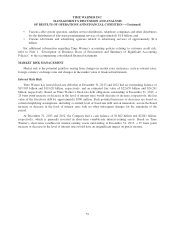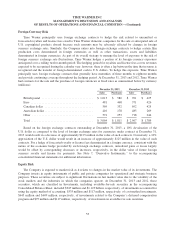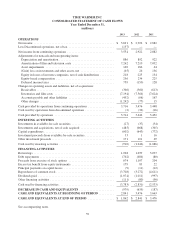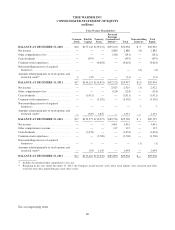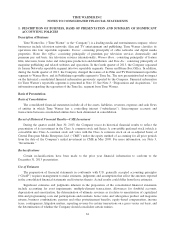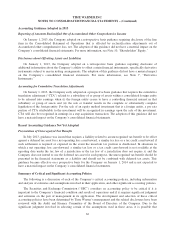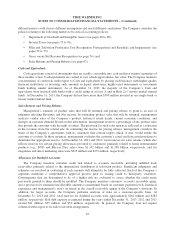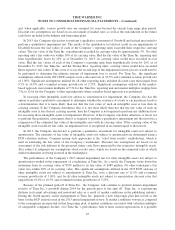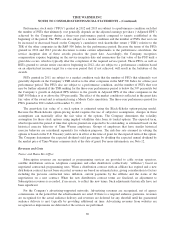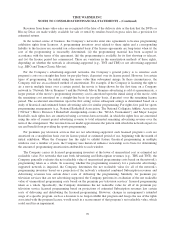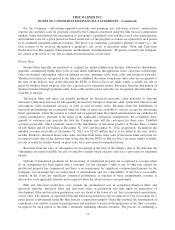Time Magazine 2013 Annual Report Download - page 77
Download and view the complete annual report
Please find page 77 of the 2013 Time Magazine annual report below. You can navigate through the pages in the report by either clicking on the pages listed below, or by using the keyword search tool below to find specific information within the annual report.TIME WARNER INC.
NOTES TO CONSOLIDATED FINANCIAL STATEMENTS
1. DESCRIPTION OF BUSINESS, BASIS OF PRESENTATION AND SUMMARY OF SIGNIFICANT
ACCOUNTING POLICIES
Description of Business
Time Warner Inc. (“Time Warner” or the “Company”) is a leading media and entertainment company, whose
businesses include television networks, film and TV entertainment and publishing. Time Warner classifies its
operations into four reportable segments: Turner: consisting principally of cable networks and digital media
properties; Home Box Office: consisting principally of premium pay television services domestically and
premium pay and basic tier television services internationally; Warner Bros.: consisting principally of feature
film, television, home video and videogame production and distribution; and Time Inc.: consisting principally of
magazine publishing and related websites and operations. In the fourth quarter of 2013, the Company separated
its former Networks reportable segment into two reportable segments: Turner and Home Box Office. In addition,
during the fourth quarter of 2013, the Company changed the names of its Film and TV Entertainment reportable
segment to Warner Bros. and its Publishing reportable segment to Time Inc. The new presentation had no impact
on the historical consolidated financial information previously reported by the Company. Financial information
for Time Warner’s reportable segments is presented in Note 15. See Note 3, “Dispositions and Acquisitions,” for
information regarding the separation of the Time Inc. segment from Time Warner.
Basis of Presentation
Basis of Consolidation
The consolidated financial statements include all of the assets, liabilities, revenues, expenses and cash flows
of entities in which Time Warner has a controlling interest (“subsidiaries”). Intercompany accounts and
transactions between consolidated entities have been eliminated in consolidation.
Recast of Historical Financial Results—CME Investment
During the quarter ended June 30, 2013, the Company recast its historical financial results to reflect the
presentation of its investment in the Class A common stock and Series A convertible preferred stock (which is
convertible into Class A common stock and votes with the Class A common stock on an as-adjusted basis) of
Central European Media Enterprises Ltd. (“CME”) under the equity method of accounting for all prior periods
from the date of the Company’s initial investment in CME in May 2009. For more information, see Note 3,
“Investments.”
Reclassifications
Certain reclassifications have been made to the prior year financial information to conform to the
December 31, 2013 presentation.
Use of Estimates
The preparation of financial statements in conformity with U.S. generally accepted accounting principles
(“GAAP”) requires management to make estimates, judgments and assumptions that affect the amounts reported
in the consolidated financial statements and footnotes thereto. Actual results could differ from those estimates.
Significant estimates and judgments inherent in the preparation of the consolidated financial statements
include accounting for asset impairments, multiple-element transactions, allowances for doubtful accounts,
depreciation and amortization, the determination of ultimate revenues as it relates to amortization of capitalized
film and programming costs and participations and residuals, home video and videogames product and magazine
returns, business combinations, pension and other postretirement benefits, equity-based compensation, income
taxes, contingencies, litigation matters, reporting revenue for certain transactions on a gross versus net basis, and
the determination of whether the Company should consolidate certain entities.
61



